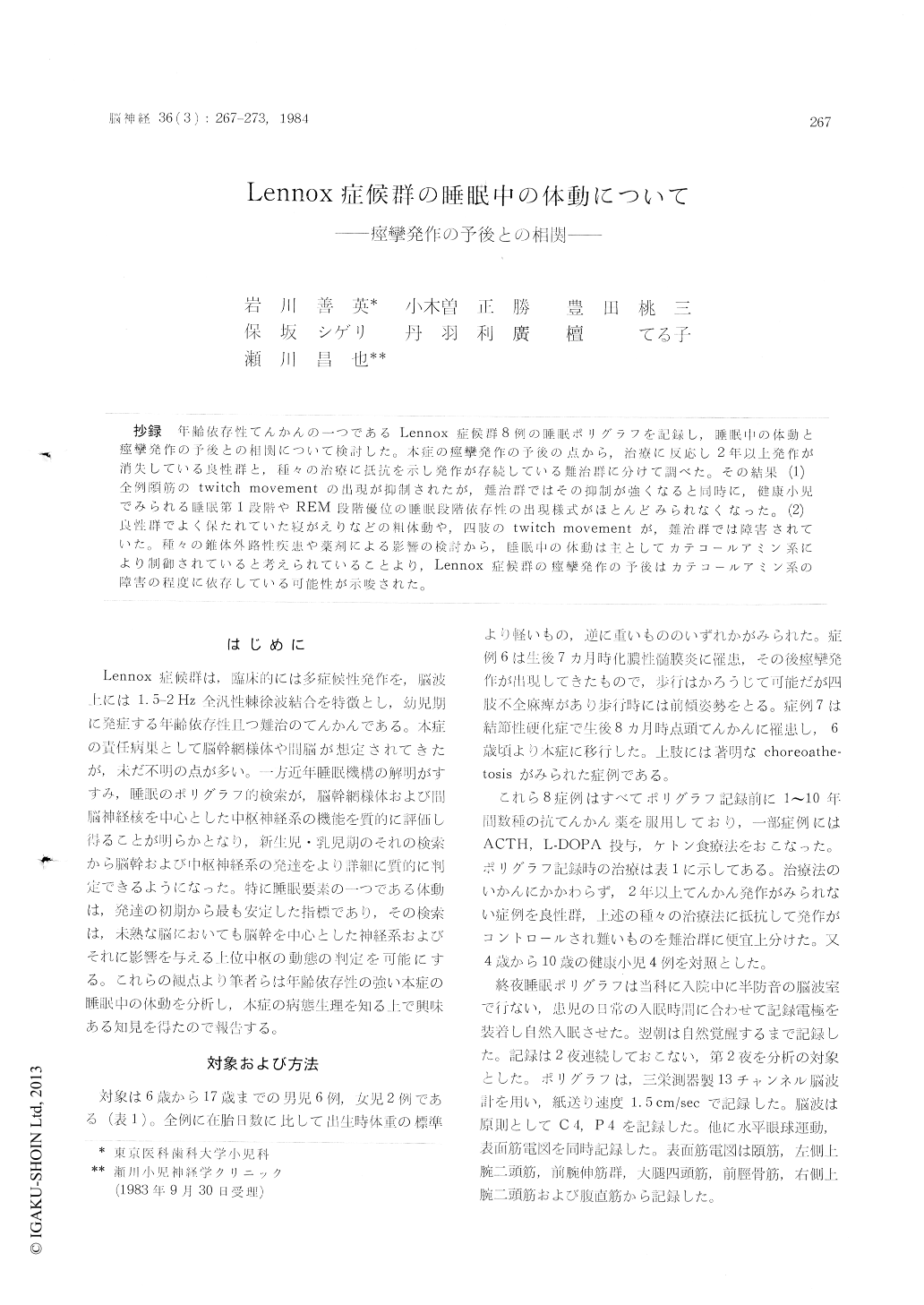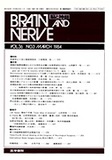Japanese
English
- 有料閲覧
- Abstract 文献概要
- 1ページ目 Look Inside
抄録 年齢依存性てんかんの一つであるLennox症候群8例の睡眠ポリグラフを記録し,睡眠中の体動と痙攣発作の後との相関について検討した。本症の痙攣発作の予後の点から,治療に反応し2年以上発作が消失している良性群と,種々の治療に抵抗を示し発作が存続している難治群に分けて調べた。その結果(1)全例頤筋のtwitch movementの出現が抑制されたが,難治群ではその抑制が強くなると同時に,健康小児でみられる睡眠第1段階やREM段階優位の睡眠段階依存性の出現様式がほとんどみられなくなった。(2)良性群でよく保たれていた寝がえりなどの粗体動や,四肢のtwitch movementが,難治群では障害されていた.種々の錐体外路性疾患や薬剤による影響の検討から,睡眠中の体動は主としてカテコールアミン系により制御されていると考えられていることより,Lennox症候群の痙攣発作の予後はカテコールアミン系の障害の程度に依存している可能性が示唆された。
In Lennox syndrome the brainstem which playsimportant roles in regulating sleep and its para-meters is thought to be disturbed. In order to clarify the importance of the dysfunction of the brainstem in Lennox syndrome, polygraphic exa-mination were studied and their findings were assessed with prognosis.
8 patients aged from 6 to 17 years were sub-jected to this study. They were divided into two groups accordiing to their prognosis. Group 1 showed good prognosis. Seizures were easily cont-rollable and have not occured for more than 24 months. In group 2 seizures were intractable and were uncontrollable by medication. In 4 normal children ranging in age from 4 to 10 years, the same studies were performed. Recordings were performed on two consective nights and the second night recordings were used for analysis. Polygraph consisted of EEG from C 4 and P 4, bipolar EOG from electrode attached to outer canthus, surface EMG from submental muscle and 5 or 6 other muscles including trunk and limbs. Sleep stages were determined in each minute according to the standard of APSS. Body movements were classified into two types on the basis of their distribution over body parts and on duration of movements. Gross movements (GM) involved the body trunk and lasted for more than two seconds. Twitch movements (TM) were localized in one muscle on surface EMG recordings lasting less than 0.5 se-conds.
In normal children, the rate of GM in sleep stage 1 and REM are significantly higher than slow wave sleep. And this is the same in TM ofall muscles. The frequency of TM of submental muscle is more prominent than any other muscles. Frequency of body movements tends to decrease with increasing age.
In group 1 distribution of body movements against each sleep stages were almost normal. But the frequency of TM of submental muscle is signi-ficantly low compared to the normal children.
In group 2 not only frequency but also distribu-tion of TM against each sleep stages were abnor-mal. Moreover GM showed abnormal distribution against sleep stages.
In one case of group 2, seizures as well as body movements were partially improved by administ-ration of L-DOPA.
Cases of hereditary progressive dystonia with durnal fluctuation show low frequency of body movements during sleep and abnormal distribution against sleep stages. With administration of L-DOPA, symptoms of these patients such as dystonia disappeared, and the frequency of body movements increased. In Parkinson's disease this is also the case. These facts suggest that body movements during sleep are related to the catecholaminergic system.
Our data reflect the abnormality of catechola-minergic system in Lennox syndrome. The clinical and polygraphic improvement in a patient of group 2 caused by the administration of L-DOPA would also indicate the contribution of catecholaminergic system to the prognosis of Lennox syndrome.

Copyright © 1984, Igaku-Shoin Ltd. All rights reserved.


